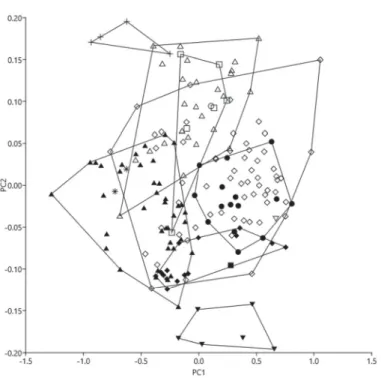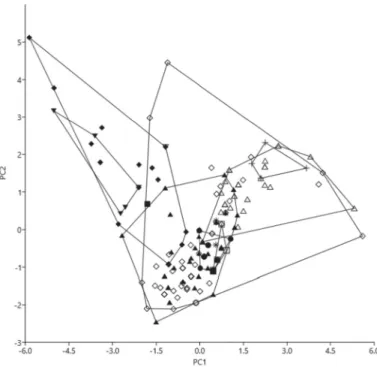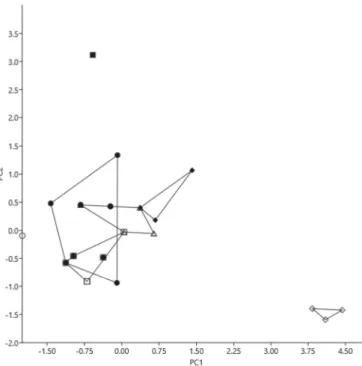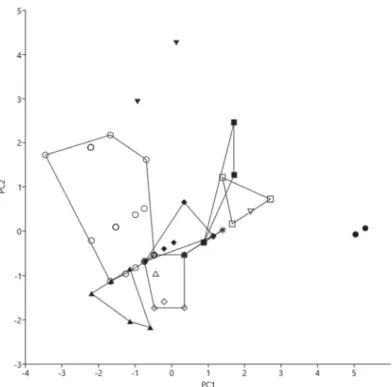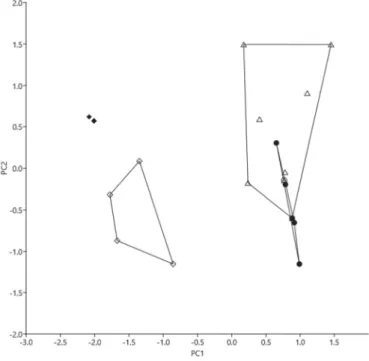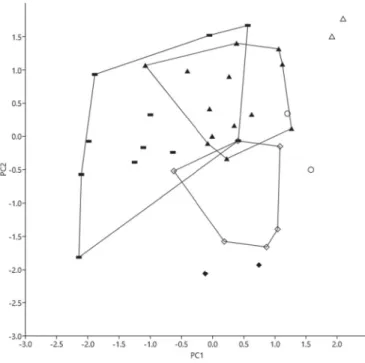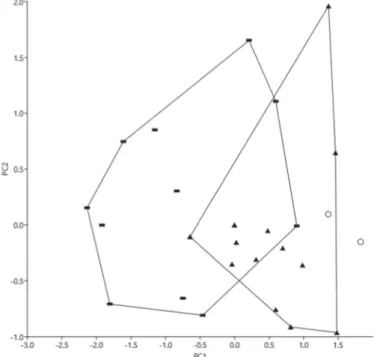European Journal of Taxonomy 314: 1–8 ISSN 2118-9773 https://doi.org/10.5852/ejt.2017.314 www.europeanjournaloftaxonomy.eu 2017 · Van Ginneken M. et al.
This work is licensed under a Creative Commons Attribution 3.0 License.
C o r r i g e n d u m
The following corrections have been made to paper no. 310 (https://doi.org/10.5852/ejt.2017.310)
Morphometry and DNA barcoding reveal cryptic diversity in the genus Enteromius (Cypriniformes: Cyprinidae)
from the Congo basin, Africa – Corrigendum
Marjolein VAN GINNEKEN
1,†, Eva DECRU
2,*,†, Erik VERHEYEN
3& Jos SNOEKS
41 Department of Biology, Systemic Physiological and Ecotoxicological Research, University of Antwerp, Groenenborgerlaan 171, 2020 Antwerpen, Belgium.
2,4 Royal Museum for Central Africa, Section Vertebrates, Ichthyology, Leuvensesteenweg 13, 3080 Tervuren, Belgium.
2,4 Department of Biology, Laboratory of Biodiversity and Evolutionary Genomics, KU Leuven, Charles Deberiotstraat 32, 3000 Leuven, Belgium.
3 Royal Belgian Institute of Natural Sciences, OD Taxonomy and Phylogeny, Vautierstraat 29, 1000 Brussels, Belgium; Department of Biology, Evolutionary Ecology Group, University of Antwerpen,
Campus Drie Eiken, building D, room D.150 Universiteitsplein 1, 2610 Antwerpen, Belgium.
† Equally contributing authors
* Corresponding author: eva.decru@africamuseum.be
1 Email: marjolein.vanginneken@uantwerpen.be
3Email: everheyen@naturalsciences.be
4 Email: jos.snoeks@africamuseum.be
Van Ginneken M., Decru E., Verheyen E. & Snoeks J. 2017. Morphometry and DNA barcoding reveal cryptic diversity in the genus Enteromius (Cypriniformes: Cyprinidae) from the Congo basin, Africa – Corrigendum.
European Journal of Taxonomy 314: 1–8. https://doi.org/10.5852/ejt.2017.314
In the original publication, Figs 3–9 were accidentally published in low resolution. The high resolution fi gures with their captions are published below. Figs 8–9 showed a white rectangle for ‘Ituri 8’, which should have been a black rectangle, herewith updated. The captions have not changed.
European Journal of Taxonomy 314: 1–8 (2017)
Fig. 3. Scatterplot of PC2 against PC1 for a PCA on 17 log-transformed measurements (n = 177) of Enteromius Cope, 1867: E. cf. miolepis (Boulenger, 1902) (◊), E. cf. brazzai (Pellegrin, 1901) (♦), E. cf.
pellegrini (Poll, 1939) (∆), and E. cf. atromaculatus (Nichols & Griscom, 1917) (▲). Also shown are the type specimens examined of: E. miolepis (Boulenger, 1902) (○), E. holotaenia (Boulenger, 1904) (●), E. eutaenia (Boulenger, 1904) (□), E. kerstenii (Peters, 1868) (■), E. brazzai (Pellegrin, 1901) ( ), E. tshopoensis (De Vos, 1991) (▼), E. pellegrini (Poll, 1939) (+), and E. atromaculatus (Nichols &
Griscom, 1917) ( ).
VAN GINNEKEN M. et al., Unexpected cryptic diversity in Enteromius
Fig. 4. Scatterplot of PC2 against PC1 for a PCA on 10 meristics (n = 177) of Enteromius: E. cf.
miolepis (Boulenger, 1902) (◊), E. cf. brazzai (Pellegrin, 1901) (♦), E. cf. pellegrini (Poll, 1939) (∆), and E. cf. atromaculatus (Nichols & Griscom, 1917) (▲). Also shown are the type specimens examined of:
E. miolepis (Boulenger, 1902) (○), E. holotaenia (Boulenger, 1904) (●), E. eutaenia (Boulenger, 1904) (□), E. kerstenii (Peters, 1868) (■), E. brazzai (Pellegrin, 1901) ( ), E. tshopoensis (De Vos, 1991) (▼), E. pellegrini (Poll, 1939) (+), and E. atromaculatus (Nichols & Griscom, 1917) ( ).
European Journal of Taxonomy 314: 1–8 (2017)
Fig. 5. Scatterplot of PC2 against PC1 for a PCA on 10 meristics (n = 36) of E. cf. miolepis specimens from the Lower Congo: Inkisi (◊), Luki 1 (♦) and Luki 2 (∆). Also shown are the type specimens examined of: E. miolepis (Boulenger, 1902) (○), E. holotaenia (Boulenger, 1904) (●), E. eutaenia (Boulenger, 1904) (□) and E. kerstenii (Peters, 1868) (■).
VAN GINNEKEN M. et al., Unexpected cryptic diversity in Enteromius
Fig. 6. Scatterplot of PC2 against PC1 for a PCA on 8 meristics (n = 60) of E. cf. miolepis (Boulenger, 1902) specimens from the Congo basin (excluding types): ‘Kisangani region’ 1 (◊), Ituri 1 (♦), Itimbiri (∆), Léfi ni (▲), Epulu 1 (○), Inkisi (●), Luapula 1 (□), Luki 1 (■), Luapula 2 ( ), Luapula 3 (▼), Ituri 2 (+), and Luki 2 ( ). Specimens from Luapula 1 and Luapula 2 can be separated from each other based on a PCA on the log-transformed measurements; specimens of Luki 2 fall separated when barbel lengths are included; specimens from ‘Kisangani region’ 1 and Itimbiri can be distinguished based on colour pattern.
European Journal of Taxonomy 314: 1–8 (2017)
Fig. 7. Scatterplot of PC2 against PC1 for a PCA on 10 meristics (n = 22) of E. cf. brazzai (Pellegrin, 1901): ‘Kisangani region’ 2 (◊), Ituri 3 (♦) and ‘Kisangani region’ 3 (∆). Also shown are the type specimens examined of E. brazzai (Pellegrin, 1901) (○) and E. tshopoensis (De Vos, 1991) (●).
VAN GINNEKEN M. et al., Unexpected cryptic diversity in Enteromius
Fig. 8. Scatterplot of PC2 against PC1 for a PCA on 10 meristics (n = 42) of E. cf. atromaculatus (Nichols & Griscom, 1917): Ituri 5 (◊), Ituri 6 (♦), Ituri/‘Kisangani region’ (∆), Epulu 2 (▲), and Ituri 8 ( ). Also shown are the type specimens of E. atromaculatus (Nichols & Griscom, 1917) (○).
European Journal of Taxonomy 314: 1–8 (2017)
Published on: 28 April 2017
Printed versions of all papers are also deposited in the libraries of the institutes that are members of the EJT consortium: Muséum national d’Histoire naturelle, Paris, France; Botanic Garden Meise, Belgium;
Fig. 9. Scatterplot of PC2 against PC1 for a PCA on 10 meristics (n = 36) of E. cf. atromaculatus (Nichols & Griscom, 1917): Epulu 2 (▲), and Ituri 8 ( ). Also shown are the type specimens of E. atromaculatus (Nichols & Griscom, 1917) (○).
